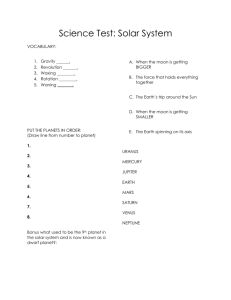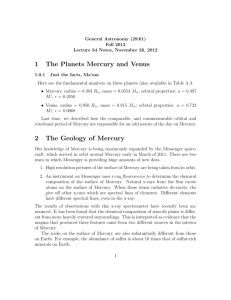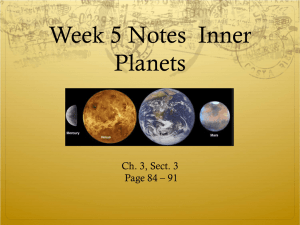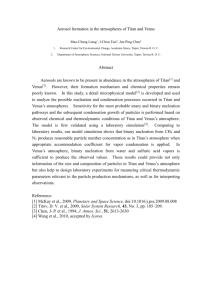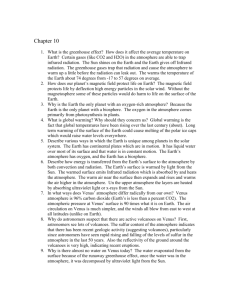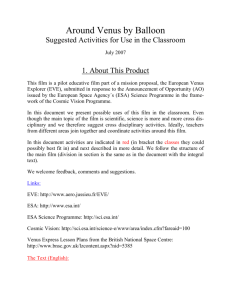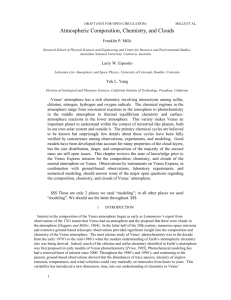Astronomy Review – Mercury & Venus Name: Date: Venus
advertisement
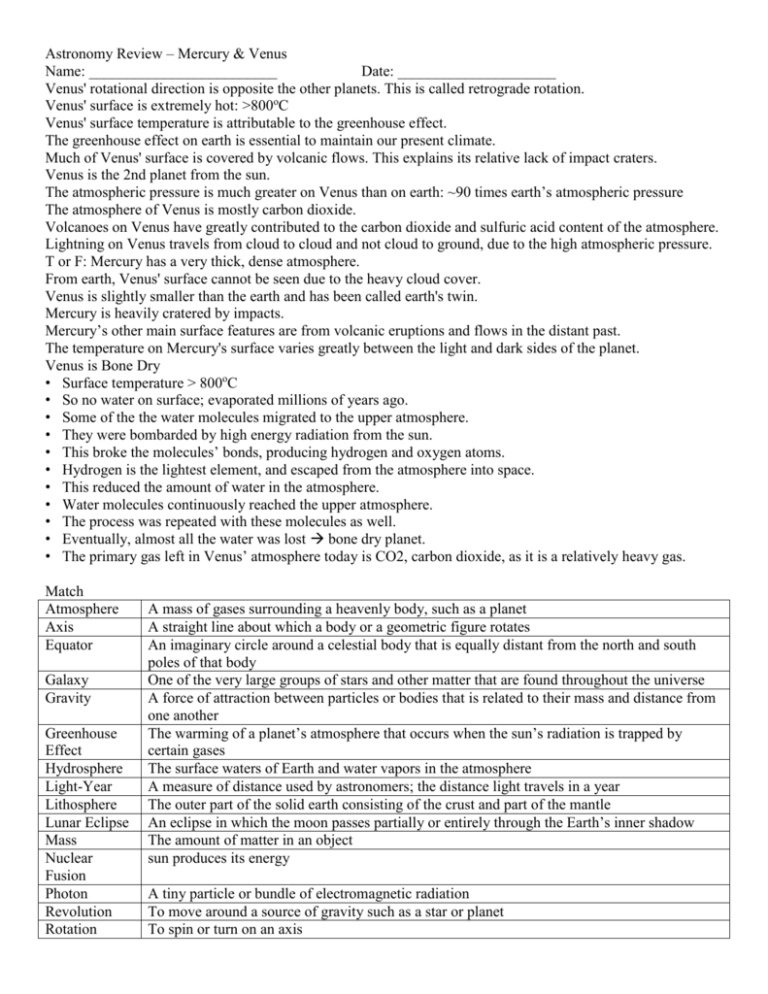
Astronomy Review – Mercury & Venus Name: _________________________ Date: _____________________ Venus' rotational direction is opposite the other planets. This is called retrograde rotation. Venus' surface is extremely hot: >800oC Venus' surface temperature is attributable to the greenhouse effect. The greenhouse effect on earth is essential to maintain our present climate. Much of Venus' surface is covered by volcanic flows. This explains its relative lack of impact craters. Venus is the 2nd planet from the sun. The atmospheric pressure is much greater on Venus than on earth: ~90 times earth’s atmospheric pressure The atmosphere of Venus is mostly carbon dioxide. Volcanoes on Venus have greatly contributed to the carbon dioxide and sulfuric acid content of the atmosphere. Lightning on Venus travels from cloud to cloud and not cloud to ground, due to the high atmospheric pressure. T or F: Mercury has a very thick, dense atmosphere. From earth, Venus' surface cannot be seen due to the heavy cloud cover. Venus is slightly smaller than the earth and has been called earth's twin. Mercury is heavily cratered by impacts. Mercury’s other main surface features are from volcanic eruptions and flows in the distant past. The temperature on Mercury's surface varies greatly between the light and dark sides of the planet. Venus is Bone Dry • Surface temperature > 800oC • So no water on surface; evaporated millions of years ago. • Some of the the water molecules migrated to the upper atmosphere. • They were bombarded by high energy radiation from the sun. • This broke the molecules’ bonds, producing hydrogen and oxygen atoms. • Hydrogen is the lightest element, and escaped from the atmosphere into space. • This reduced the amount of water in the atmosphere. • Water molecules continuously reached the upper atmosphere. • The process was repeated with these molecules as well. • Eventually, almost all the water was lost bone dry planet. • The primary gas left in Venus’ atmosphere today is CO2, carbon dioxide, as it is a relatively heavy gas. Match Atmosphere Axis Equator Galaxy Gravity Greenhouse Effect Hydrosphere Light-Year Lithosphere Lunar Eclipse Mass Nuclear Fusion Photon Revolution Rotation A mass of gases surrounding a heavenly body, such as a planet A straight line about which a body or a geometric figure rotates An imaginary circle around a celestial body that is equally distant from the north and south poles of that body One of the very large groups of stars and other matter that are found throughout the universe A force of attraction between particles or bodies that is related to their mass and distance from one another The warming of a planet’s atmosphere that occurs when the sun’s radiation is trapped by certain gases The surface waters of Earth and water vapors in the atmosphere A measure of distance used by astronomers; the distance light travels in a year The outer part of the solid earth consisting of the crust and part of the mantle An eclipse in which the moon passes partially or entirely through the Earth’s inner shadow The amount of matter in an object sun produces its energy A tiny particle or bundle of electromagnetic radiation To move around a source of gravity such as a star or planet To spin or turn on an axis Solar Eclipse Solar Wind Sunspots Terrestrial Weight An eclipse of the sun by the moon Electronically charged particles that spray out from the sun Dark blotches on the surface of the sun Earthlike The measure of an object’s gravitational attraction The Earth isn’t cratered like the moon and Mercury because most objects burn up in the atmosphere before reaching the ground. There is a large impact crater on earth in Arizona, created ~50,000 years ago. Venus has the highest surface temperature of all the planets because it has experienced a runaway greenhouse effect. Plate tectonics: The upper crust of the Earth is broken into pieces that slowly move around and are suspended on the mantle. Because of its extremely slow rotation, Mercury’s day is longer than its year. Mercury is believed to be completely solidified, i.e. no molten mantle, core, etc. How are the four inner planets similar to one another? All have solid surfaces with iron cores. Why does nuclear fusion hold promise as an energy source? It would be virtually unlimited and not subject to being used up like fossil fuels. When we look into the night sky we are actually looking into the past. How do you explain this? Distances in outer space are so tremendous that it takes years for the light from stars to reach our planet. The strength of gravitational force depends on: 1) the masses of the objects; 2) their distance from each other. The nine planets in our solar system revolve around the sun because it has the greatest mass and, therefore, the strongest gravitational attraction. During a spacewalk astronauts and cosmonauts must wear a protective spacesuit. What are the hazards these individuals face? Radiation, lack of air, extreme temperatures




